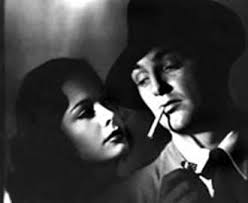Film noir is a cinematic term used primarily to describe stylish Hollywood crime dramas, particularly those that emphasize cynical attitudes and sexual motivations. Hollywood
Storylines were often elliptical, non-linear and twisting. Narratives were frequently complex, maze-like and convoluted, and typically told with foreboding background music, flashbacks (or a series of flashbacks), witty, razor-sharp and acerbic dialogue, and/or reflective and confessional, first-person voice-over narration. Amnesia suffered by the protagonist was a common plot device, as was the downfall of an innocent Everyman who fell victim to temptation or was framed. Revelations regarding the hero were made to explain/justify the hero's own cynical perspective on life.Film noir films (mostly shot in gloomy grays, blacks and whites) thematically showed the dark and inhumane side of human nature with cynicism and doomed love, and they emphasized the brutal, unhealthy, seamy, shadowy, dark and sadistic sides of the human experience. An oppressive atmosphere of menace, pessimism, anxiety, suspicion that anything can go wrong, dingy realism, futility, fatalism, defeat and entrapment were stylized characteristics of film noir. The protagonists in film noir were normally driven by their past or by human weakness to repeat former mistakes.
Film noir films were marked visually by expressionistic lighting, deep-focus or depth of field camera work, disorienting visual schemes, jarring editing or juxtaposition of elements, ominous shadows, skewed camera angles (usually vertical or diagonal rather than horizontal), circling cigarette smoke, existential sensibilities, and unbalanced or moody compositions. Settings were often interiors with low-key (or single-source) lighting, venetian-blinded windows and rooms, and dark, claustrophobic, gloomy appearances. Exteriors were often urban night scenes with deep shadows, wet asphalt, dark alleyways, rain-slicked or mean streets, flashing neon lights, and low key lighting. Story locations were often in murky and dark streets, dimly-lit and low-rent apartments and hotel rooms of big cities, or abandoned warehouses.

http://www.google.co.uk/imgres?imgurl=http://filmsnoir.net/wp-content/uploads/2007/06/outpast1.jpeg&imgrefurl=http://filmsnoir.net/films/10-must-see-dark-delights-of-film-noir.html&usg=__uBD-lcJU24-2F_ieWwb_VdLjM0U=&h=271&w=330&sz=12&hl=en&start=0&zoom=1&tbnid=ydfWuxI5rQGhVM:&tbnh=127&tbnw=155&prev=/images%3Fq%3Dfilm%2Bnoir%26um%3D1%26hl%3Den%26safe%3Dactive%26sa%3DN%26biw%3D1260%26bih%3D837%26tbs%3Disch:1&um=1&itbs=1&iact=rc&dur=375&ei=SFriTID-DIK6hAe5wqncDA&oei=SFriTID-DIK6hAe5wqncDA&esq=1&page=1&ndsp=35&ved=1t:429,r:10,s:0&tx=102&ty=48
This image uses a filer light which helps soften the shadows in the image which may have been created by any other shadows. The still image is quite dark and there is a plain background. The light is hitting the side of the woman's face and hitting the male's face with the cigarette being reflected onto his face. The lighting used in this image is creating a shadow, this has been done by using high-key lighting which makes the image to be more realistic.
The woman in the still image is looking onto the male in the still image and he is looking down, this connotes the romance between the characters however they have no facial expressions and we can only read their emotions through their eyes. The cigarette in the male's mouth connotes that he may be stressed and he always is looking down in the image, which connotes he may have a low opinion of himself. We can not see what the woman in the still image is wearing however the male is seen to be wearing a suit which connotes to us that he high professional .

No comments:
Post a Comment